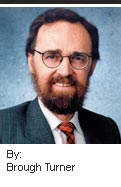|
October 2007 | Volume 10 / Number 10
The Next Wave Redux
U.S. Wireless Broadband to be Extremely Competitive
Luckily, all this is about to change. By early 2009, the U.S. market for wireless broadband Internet access will be extremely competitive, for several reasons. First, in the 2006 AWS auctions, T-Mobile USA spent $4.2 billion on spectrum, giving them a national footprint. They then committed $2.7 billion for a 3G UMTS network, currently scheduled to be complete by the end of 2008. Second, Sprint, which already runs a 3G EVDO Rev A network, is spending US$3 billion to build a WiMAX network on 2.5 GHz spectrum acquired when they bought Nextel. Some have questioned whether Sprint can afford to complete this second national network, but their partnerships with cable companies and, more recently with Clearwire, suggest there are enough interested parties to ensure this build out is completed. Thus by early 2009, the U.S. will have four national mobile networks: • AT&T Mobility (formerly Cingular) using W-CDMA with HSDPA and eventually HSUPA • T-Mobile USA deploying W-CDMA with HSDPA and then HSUPA • Verizon using CDMA 2000 EVDO Rev A and later Rev B • Sprint using CDMA 2000 EVDO Rev A and later Rev B (and partnered with four major cable companies) In addition, WiMAX should be available in all major markets with the balance of a national footprint built out during 2009 and 2010; i.e.: • Sprint XOHM (pronounced zoam) using WiMAX at 2.5 GHz in partnership with Clearwire Four competitors is a magic number. One operator is a monopoly. Two or three operators typically form a stable oligopoly. There’s competition and evolution, but it’s controlled - no one goes bankrupt, no one takes over. However, markets with four or more viable competitors go wild, to the benefit of consumers. We’ve seen this effect in the evolution of mobile voice services in many countries around the world. Markets with four or more viable competitors experience hyper competition. By early 2009, the U.S. will have at least four national brands and five national wireless broadband networks. In addition, many areas have 2nd tier mobile operators (like US Cellular, Leap Wireless or MetroPCS). And of course, both individual and networked WiFi hotspots continue to proliferate. Expect hyper competition leading to low cost, flat-rate data bundles. Certainly wireless market evolution will outpace that of fixed broadband access, which remains hostage to a duopoly - actually two monopolies (cable & ILEC) operating under different legal and regulatory schemes, that are just beginning to compete. Is wireless broadband access fast enough? Well nothing is ‘fast enough,’ but users should get more than 1 Mbps downstream and 100-300 Kbps upstream, with additional speed increases every 18 months or so. That’s small compared to the speed of fiber today, but when DSL and cable Internet services first achieved these speeds, VoIP companies (like Vonage and Skype) sprang up and new applications (like peer-to-peer file sharing) swept the Internet. So 2009 should bring low cost flat-rate wireless broadband access to the U.S. and that in turn will foster a new round of 3rd party applications that leverage affordable mobile broadband Internet access. Will hyper competition continue? Yes, barring major legal or regulatory screw ups (which at this point seem unlikely). Wireless technology continues to evolve at a great rate. And at least one more player is likely to enter the U.S. wireless market after the upcoming 700 MHz spectrum auctions scheduled for early 2008. In these auctions, 22 MHz of spectrum comes with license conditions for ‘open applications’ and ‘open access,’ i.e., the winning bidder may not block or slow wireless access or competitors’ web content, and customers may connect any wireless device to the network including handset devices from other carriers and dual- and multi-mode devices. These provisions are part of a new model that Google and various public interest groups supported. Assuming this auction goes as expected, at least one additional national network should enter the fray during 2010-2012. So wireless broadband access speeds will continue to lag fiber access speeds, but in the U.S., wireless broadband is where the action and excitement will be. IT Brough Turner is Senior VP of Technology, CTO and Co-Founder of NMS Communications. For more information, please visit the company online at www.nmscommunications.com. Today @ TMC
Headlines
Upcoming Events
MSPWorld
The World's Premier Managed Services and Cloud Computing Event Click for Dates and Locations Corporate News
|
|





 Today, US wireless Internet access is limited and expensive. It’s available nationally from mobile operators AT&T, Verizon and Sprint, and locally in some cities from wireless ISPs like Clearwire (targeting consumers) and Towerstream (for business T1 replacement). But mobile operators still focus on voice services and walled garden data services, while Clearwire is in a limited set of cities and Towerstream benefits from the high cost of ILEC T1s.
Today, US wireless Internet access is limited and expensive. It’s available nationally from mobile operators AT&T, Verizon and Sprint, and locally in some cities from wireless ISPs like Clearwire (targeting consumers) and Towerstream (for business T1 replacement). But mobile operators still focus on voice services and walled garden data services, while Clearwire is in a limited set of cities and Towerstream benefits from the high cost of ILEC T1s.
